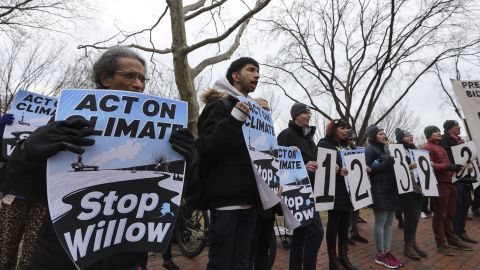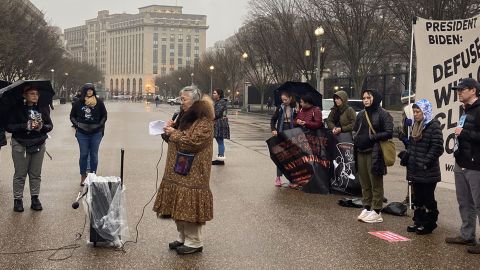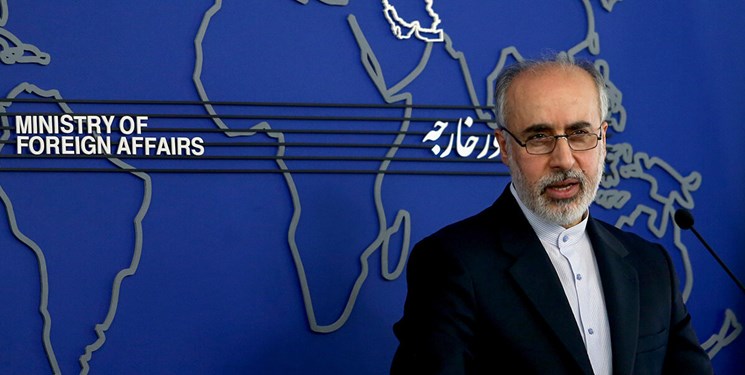By Ella Nilsen, CNN
Sun March 5, 2023

From left, Elise Joshi, Alex Haraus and Alaina Wood raise awareness of the Willow Project through TikTok.
CNN —
When Elise Joshi posted a TikTok video about the Alaska oil drilling project known as Willow in early February, she didn’t have high hopes it would go viral.
Joshi, 20, posts often about climate issues on TikTok for the account Gen-Z for Change, as well as her personal account. She’s well aware “climate doesn’t trend very often,” as she told CNN. But Joshi’s video about Willow was very different. It took just a few days to accumulate more than 100,000 views, eventually surpassing 300,000.
“It’s my most-viewed video in months,” Joshi told CNN. “This is the entire internet advocating against Willow; [President Joe Biden’s] voter base, that trusted him to act on climate.”
Biden’s administration is expected to finalize its decision on whether to approve the ConocoPhillips Willow Project next week. If it goes through, the decadeslong oil drilling venture in the on the North Slope of Alaska would create thousands of jobs and establish a new source of revenue for the region.
But it would also generate enough oil to release 9.2 million metric tons of planet-warming carbon pollution a year, by the federal government’s estimate, about the same as adding 2 million cars to the roads.
While the project has both supporters and opponents in its home state, it has become a lightning rod on social media. Over the past week, TikTok users in particular have galvanized around halting the project, with a staggering number of people watching and posting on the topic.
Videos with anti-Willow hashtags like #StopWillow have amassed close to 50 million views in the last week, and on Friday, Willow was on the site’s top 10 trending list, behind celebrities Selena Gomez and Hailey Bieber. Much of the spike in interest has come in the last week alone.
The online activism has resulted in more than one million letters being written to the White House protesting the project, as well as a Change.org petition with 2.8 million signatures and counting.
“If that doesn’t emphasize the fact that it’s everyday Americans pushing back, I don’t know what does,” said Alex Haraus, 25, a TikTok creator whose Willow videos have garnered millions of views. “This is not an environmental movement, it’s much larger than that. It’s the American public that can vote.”
The sudden growth of #StopWillow

Climate advocates gather to protest the Willow Project in Lafayette Square in front of the White House on January 10.
TikTok creators and climate groups CNN spoke to said the sudden surge in online activism around Willow has largely been organic, and much larger than any other climate issue on the app before.
Some climate and anti-fossil fuel groups have been working with specific TikTok creators and accounts around Willow, but no one group has spearheaded the online movement around the project. Similar TikTok campaigns have sprung up in the past few years around banning oil drilling in the Arctic National Wildlife Refuge and stopping the Line 3 pipeline in Minnesota, but few have captured as much attention as Willow.
“I’ve been doing this for a long time and it’s very rare to see a climate issue go viral,” said Alaina Wood, 26, a scientist, climate activist and TikTok creator.
Wood told CNN she thinks the profile of climate has grown on apps frequented by younger generations, especially given Biden’s climate law passed last year. But there is also a lot of anxiety and fear about the climate crisis on TikTok – sentiments the Willow Project has captured and amplified.
“Anytime a project like this goes viral, the climate doom also goes viral,” Wood said, adding she’s made videos to try to counter the climate doomerism proliferating among some young people. “A lot of young people are under the impression that if Willow gets passed, climate change will be irreversible. We still need to fight Willow, but your life isn’t over if it’s passed.”
The growth of #StopWillow TikTok has both befuddled and delighted legacy climate groups, some of which were wondering why it took so long for Willow to get noticed. Even though Biden has already cemented part of his legacy on climate by working with Congress to pass the most ambitious climate bill in generations, activists who fought Keystone XL and the Dakota Access Pipeline during the Obama administration say one thing remains constant: massive fossil fuel projects tend to fire people up.
“Specific fights galvanize public attention way more than policy does,” said Jamie Henn, the director of nonprofit Fossil Free Media and a former co-founder of the environmental organization 350.org. “These are the issues that capture the public imagination. It is really foolhardy to ignore that.”
The White House has shown it cares about reaching TikTok’s vast, young audience. White House officials have invited TikTok creators to the White House multiple times, including for a meeting with Biden himself about the Inflation Reduction Act in October.
“I think Democrats and the Biden administration would do well to pay attention to these trends,” said Lena Moffitt, chief of staff for climate group Evergreen Action. “Young people increasingly want climate action from their elected officials and they’re going to demand it.”
Can a grassroots, digital campaign work?

Nutaaq Simmonds of Utqiagvik, Alaska, speaks at a protest against the Willow Project in front of the White House on Friday.
Protests against Willow aren’t just happening on TikTok. On Friday, a group of about 100 people gathered in front of the White House in frigid drizzle to demonstrate against the project.
TikTok creators were thin on the ground. Those who had braved the chilly March weather included Alaska Natives and elders who had flown over 10 hours from Anchorage and villages on the North Slope to DC. Robert Thompson is one elder who made the grueling journey from his home village of Kaktovik.
Thompson told CNN he had wanted to speak about the effects of climate change on the region’s animals and spoke of over 200 caribou found dead near his home.
“We could see them from our house, it’s sad,” Thompson said, tearing up. “I was in Vietnam and saw a lot of things that were sad, but I never thought I’d see it at my home. I don’t know how you can accept it.”

This 2019 photo shows an exploratory drilling camp at the proposed site of the Willow Project on Alaska's North Slope.
Willow’s supporters – including a coalition of Alaska Natives on the North Slope – say Willow could be a much-needed new source of revenue for the region and help fund schools, health care and other basic services.
“Willow presents an opportunity to continue that investment in the communities,” Nagruk Harcharek, president of the advocacy group Voice of the Arctic Iñupiat, told CNN. “Without that money and revenue stream, we’re reliant on the state and the feds.”
But others living closer to the planned project, including city officials and tribal members in the Native village of Nuiqsut, are concerned about the health and environmental impacts of a major oil development.
“We are saying that you are not allowed to make decisions that are going to make our world unlivable,” Siqiniq Maupin, executive director of the Indigenous activist group Sovereign Iñupiat for a Living Arctic, told CNN. “We are concerned about climate change, but we’re also concerned about Indigenous rights and human rights.”
Maupin and Thompson said they will continue to fight Willow through the courts if the Biden administration approves the project. Environmental legal group Earthjustice has also been preparing a lawsuit against the project if it is approved.
“We plan to do everything in our power to stop ConocoPhillips from doing construction in Nuiqsut this winter,” Maupin said. “We are going to continue to fight this by legal means, by direct action.”
As for whether the surge of online activism will work to halt or delay the project, TikTok creators themselves aren’t sure. If the project is approved, several told CNN they will continue to post about the project – detailing ways their followers can support Indigenous groups in Alaska and keep speaking out about Willow.
“We’re coordinated enough to do whatever makes the most sense,” Haraus told CNN. “If that’s in-person protesting, then we will happily do that. This is an issue that we will be voting on and will remember at the ballot box.
“Millions of people are waiting for the White House’s move.”





